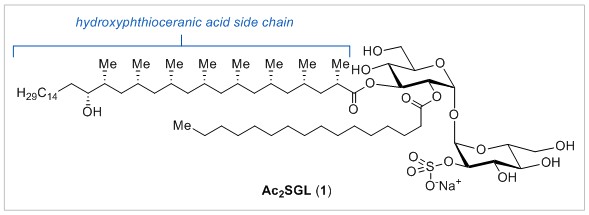Tuberculosis (TB), caused by Mycobacterium tuberculosis, is responsible for the deaths of millions of people every year, while one third of the world’s population is infected with a dormant form of the bacteria. Researchers propose that better understanding of how the immune system copes with M. tuberculosis infection could aid the design of new vaccines to limit bacteria growth, and to eradicate any latent forms. Ac2SGL (1) is a sulfoglycolipid found in the outer membrane of M. tuberculosis which has been implicated in the modulation of TB growth and development, and as such, has potential for use in a new vaccine.
The first asymmetric total synthesis of Ac2SGL has been reported by Prof. Minnaard at the Stratingh Institute for Chemistry, University of Groningen. This elegant work resulted from a large international collaboration between researchers from the Stratingh Institute and the University of Toulouse, as well as a number of experimental immunologists from University Hospital Basel and the Singapore Immunology Network at the Agency for Science, Technology and Research (A*STAR).
To synthesise the hydroxyphthioceranic acid side chain, the researchers utilised an efficient and highly stereoselective iterative process for the construction of the 1,3-syn substituted fatty acid. The sequence was comprised of reduction, Horner–Wadsworth–Emmons olefination, and copper-catalysed asymmetric 1,4-addition (shown below).
The side chain was completed using copper-catalysed asymmetric allylic substitution and platinum-catalysed diboration/oxidation to install the requisite functionality with excellent diastereoselectivity. This hydroxyphthioceranic acid residue was appended to the disaccharide trehalose. Finally, a regioselective sulfonation at the 2′-position completed the total synthesis.
The biological activity of the synthesised Ac2SGL was investigated, and found to be comparable with naturally isolated material. The researchers undertook modelling studies which shed light on Ac2SGL’s binding interactions and 3D conformation. This information, and the efficient total synthesis, facilitates further investigation into the use of Ac2SGL as a TB vaccine.
Read this ‘HOT’ Chemical Science article today:
Danny Geerdink, Bjorn ter Horst, Marco Lepore, Lucia Mori, Germain Puzo, Anna K. H. Hirsch, Martine Gilleron, Gennaro de Libero and Adriaan J. Minnaard.
Chem. Sci., 2013, DOI: 10.1039/C2SC21620E












